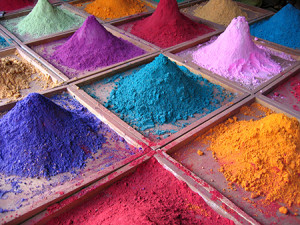What Every Oil Painter Needs to Know About Artist Oils, Part 1
At that place is such a wide selection of oil paint brands available it's hard to know where to begin. Hopefully, when you cease reading this ii-part article, you will have a little better idea of what artist oils are and which one to use.
The Ingredients in Artist Oils
Oil paints are fabricated upwards of pigment that has been ground into an oil base of operations, called the vehicle or binder. The nigh ordinarily used vehicle is cold-pressed linseed oil. Yet, creative person oils may be fabricated with walnut oil, poppy seed oil, safflower oil, or other less popular oils.
Linseed oil comes from the flaxseed and gives oil paints a longer drying fourth dimension. This allows the paint to be worked with for extended periods, sometimes even upward to several months. The advantage of a longer drying time means the artist tin can develop a painting by making changes and corrections at the creative person'south leisure. A disadvantage of longer drying times is the painting might take months or years to completely dry, depending on how thickly the paint was applied to sail. This might exist an issue if yous have a customer anxiously waiting for the painting to dry so he/she can take possession of it.

The pigment is where paint gets its color. A paint color gets its name from the pigment that is used. We showtime got our pigments from the earth in the grade of rocks or powder, simply now it is also manufactured from constructed materials. Some of the oldest pigments known to human being are made from colored earth, like Yellowish Ochre, Sienna, and Umber. Other pigments are derived from mineral salts such as White Oxide.
Paint tin be divided into two categories, these are:
-
- Natural pigments – A pigment derived from naturally occurring compounds, either inorganic, such as rocks, minerals, and metals; or organic ones, such every bit plants and animals. Examples include Mars Dark-brown, which comes from iron oxide, or Ivory Blackness that comes from charred creature bones. Natural pigments have been around for centuries and were used by the Old Masters, who would brand their paints before starting a painting session. A lot of the natural pigments in apply today are manufactured from inorganic substances.
- Synthetic pigments – An artificial pigment made by chemists from carbon-based molecules derived from petroleum substances, acids, and other chemical compounds. Nigh of the oil paints we utilise today are made from synthetic pigments, such as quinacridone, phthalocyanine, and dioxazine. Fortunately, these paints have maintained their natural pigment names for historical and cultural reasons.
Lightfastness of Creative person Oils
In that location is very piddling difference between modern-mean solar day natural and constructed pigments regarding their potency of color and ability to mix well with other oil paints. However, an important factor to consider in any pigment is its lightfastness. Lightfastness is a pigment's ability to resist fading when exposed to ultraviolet lite. This is important because it determines the length of time a pigment will retain its original color. In other words, it determines the life expectancy of the work of art. A pigment must have lightfastness, and it must not break downwardly chemically or physically if the work is going to last through the ages similar the Old Masters.
To determine the lightfastness of your oil paints, expect for the officialAmerican Society for Testing and Materials Standard (ASTM) rating information on the labels of each tube of paint. The ASTM is an independent organization that was established to create a worldwide standard for pigment permanence. The following pigment ratings were established in 1984.
Lightfastness ratings:
-
- ASTM I – Excellent
- ASTM II – Very Expert
- ASTM III – Non Sufficient enough to be used in artists' paints
Y'all would want your oil paints to accept the lightfastness of an I or 2.
To Be Continued…
This article is continued in "What Every Oil Painter Needs to Know Near Artist Oils, Part 2," where we'll take a closer look at the dissimilar grades of oil paint and what they hateful.
Take a question?
If you have a question about this painting, please contact united states of america, and we'll be happy to answer any of your questions.
Thanks for reading this!
Feel free to share this with your friends.
Enjoy this page? Please share information technology. Thanks!
Source: http://teresabernardart.com/about-artist-oils/
0 Response to "What Every Oil Painter Needs to Know About Artist Oils, Part 1"
Enregistrer un commentaire